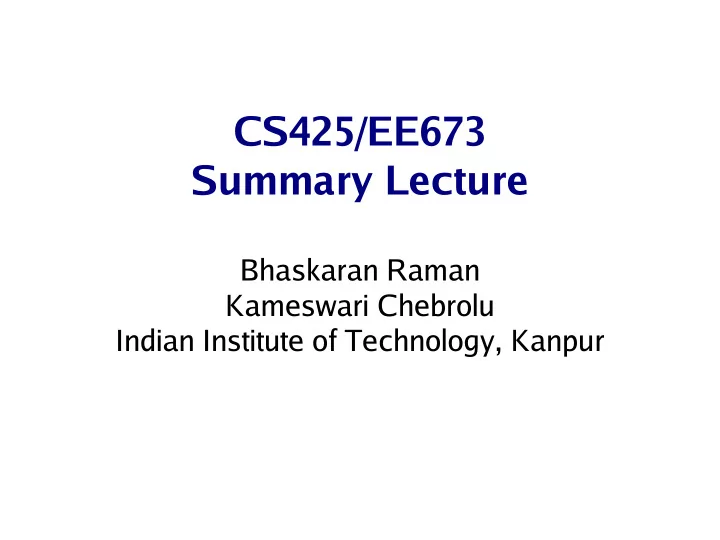

CS425/EE673 Summary Lecture Bhaskaran Raman Kameswari Chebrolu Indian Institute of Technology, Kanpur
Network Layering ● What is layering? ● Purpose of layering ● Inter-layer communication ● Encapsulation ● End-to-end versus hop-by-hop communication
Encoding Schemes ● NRZ; problems with NRZ ● NRZI ● Manchester: 50% efficiency ● 4B/5B: 80% efficiency
Framing ● Byte-oriented versus bit-oriented ● Byte-counting based versus sentinel based ● Bit/byte stuffing ● Example protocols: – BISYNC, HDLC
Error Detection ● Parity scheme ● 2D parity ● Checksum (used by IP) ● CRC: based on polynomial division ● Forward Error Correction (FEC) as an extension of error detection mechanisms
Reliable Link Layer: ARQ ● Stop-and-Wait ● Notion of Bandwidth x Delay Product ● Sliding window – Sequence space required – Variables to be maintained ● Concurrent logical channels
Beyond a Single Link ● Network topologies: – Bus – Ring – Star ● Need MAC (Medium Access Control)
MAC Protocols ● Aloha ● Slotted Aloha ● Ethernet CSMA/CD
Ethernet: a Case Study ● Maximum length possible, repeaters ● Frame format, MTU size ● CSMA/CD: – Listen before transmit – Collision detection – Backoff on collision ● 32-bit jamming sequence
Token Ring: a Case Study ● Token circulates the ring – Token rotation time – Early versus delayed release ● Token monitor – Ensures that token is always there in the ring – Checks for corrupted/orphaned frames
Packet Switching ● Store and forward functionality ● Circuit switching versus packet switching ● Datagrams ● Virtual circuit switching ● Comparison between circuit switching, packet switching, and virtual circuit switching
Ethernet Bridging ● Special case of datagram switching ● Learning bridges ● Spanning tree – Tree properties – Distributed algorithm to form a spanning tree ● Disadvantages of bridging – Trees poor for routing, fault tolerance – Metric-based routing not possible
Routing Protocols ● Distance Vector routing – Periodic updates, triggered updates – Count-to-infinity problem, split horizon, poison reverse, hold time ● Link State routing – Reliable flooding – Periodic updates, triggered updates – Sequence numbers, TTL ● Comparison between DV & LS
Internet Addressing ● Hierarchical addressing – Class A, B, C, D, E – Subnets – Forwarding algorithm ● IP header formatting & fragmentation ● ARP (Address Resolution Protocols) ● DHCP (Dynamic Host Configuration Protocol)
Internet Routing ● Hierarchical routing ● CIDR ● Internet domains, Autonomous Systems (AS) ● Path vector routing across AS – Destinations are networks – Stub AS versus transit AS ● Internet Service Providers (ISPs)
Transport Protocol ● Application requirements: reliability, in-order delivery ● Multiplexing/demultiplexing ● UDP & TCP ● Link layer reliability vs transport layer reliability
TCP ● Header format ● Connection establishment ● State transition diagram ● Slow start, congestion avoidance ● Fast retransmit & fast recovery ● RTT estimation, Jacobson/Karels algorithm ● Sequence space wrap-around
DNS ● Name space, binding, name resolution ● Hierarchical name space ● Resource Records ● Zones ● DNS query process
Applications ● HTTP: – URL – Request, Reply, persistent connections – Proxies and caching, end-to-end issues ● SMTP – RFC822, MIME, SMTP exchanges – Gateway
Network Security ● Cryptography, shared-key ● Cryptanalysis, types of attacks ● DES ● Key management ● Public key cryptography
Recommend
More recommend